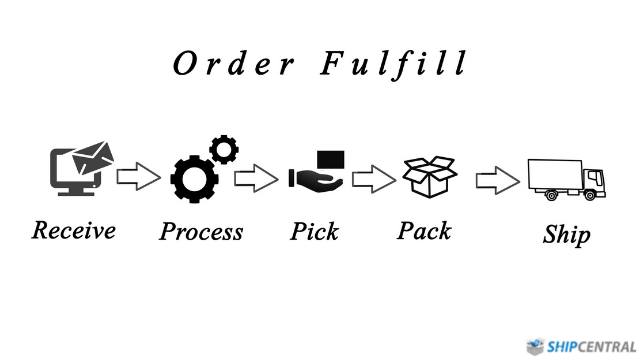It doesn’t matter if your business is small, medium or large, fulfillment can be confusing and stressful. Deciding how you’re going to fulfill your customer’s orders is a big decision and it can have a major impact on how people view your brand.
But since you’re busy here’s your quick start guide to e-commerce fulfillment. This will give you the foundation you need to dive deeper when you’re ready.
What is E-commerce Fulfillment?

E-commerce fulfillment is the entire process of getting an order delivered to a customer. At first glance this might seem like a simple process, a deeper look reveals that fulfillment and the steps that make up your supply chain are far more complex.
On the surface order fulfillment only has a few steps:
- Receive an order
- Process that order
- Pick the products for the order
- Pack the order
- Ship the order
But fulfillment (whether you’re doing it yourself or outsourcing it) has a lot more steps than just the five listed above.
- Warehouse management
- Inventory management
- Order management
- Returns processing
- Customer communication
- Negotiating shipping costs
- Order tracking
- Etc.
With E-commerce fulfillment you could be doing all, some or none of these steps depending on what approach you plan on taking. Before we jump into the three possible methods for managing your order fulfillment, let’s discuss how fulfillment can shape your brand.
How Fulfillment Shapes Your Brand
A lot of people believe that your brand is your logo when in fact your logo is only a very small part of what defines your brand. All the best marketing in the world isn’t going to be able to make up for a poor customer experience and at its core customer experience is the true heart of your brand.

Many companies do everything they can to secure a lead and obtain a new customer but, often, once that customer has made a purchase the company’s attention to detail disappears. Just as much attention should be put into the post-transaction since that can mean the difference between a lifelong customer and a lost customer.
Receiving an order that is wrong, damaged or late has the potential to leave the customer with a sour taste in their mouth; A resounding majority of customers only give you one chance, so it’s important not to blow it.
That’s why e-commerce fulfillment is so important. When you have no face-to-face interaction with your customer the interaction that you do have needs to be spot on.
Keep this in mind as we discuss different approaches to e-commerce fulfillment in the next section.
3 Approaches to E-Commerce Fulfillment
E-commerce fulfillment has three main approaches: drop shipping, third-party logistics (3PL), or self-fulfillment. Each one has its own model, uses, and pros and cons. There is no one method that is “best,” but there probably is a method that is best for you and your business.

Drop Shipping
The defining characteristic of drop shipping is that you (the business owner) do not own any inventory. You only pay for the inventory you sell after you sell it. You’re essentially the middle man, only handling marketing and sales and the drop shipper takes care of the rest.
Here’s how it works:
- You work with a drop shipper whose products you will sell.
- Someone buys a product from your site.
- The drop shipper ships them the product.
- You pay the drop shipper.
Often times margins are slim in the world of drop shipping because the drop shipper is taking much of the responsibility and risk. You’re going to be paying more per product than if you were to buy in bulk and ship with either of the methods below.
Third-Party Logistics
Third-party logistics or 3PL is characterized by the fact that you own the product but the 3PL takes care of the fulfillment process. You might have heard them called order fulfillment companies or order fulfillment centers.
A 3PL is most often for people who have a product that is uniquely their own unlike drop shippers who are selling the same product as many other people, potentially.
Here’s how it works:
- You send your inventory to the 3PL.
- It gets stored in their warehouse.
- When a customer places an order they process it.
- The order is then shipped to your customer.
When it comes to a 3PL you have more control over the customer experience because you’re selling your own product whereas with drop shipping you’re selling the drop shipper’s product.
Self-Fulfillment
Self-fulfillment is the DIY option. It’s all you, the whole process. From warehousing to order management to pick, packing, and shipping. While self-fulfillment can be a cheap option for small to mid-sized companies starting out, it can cost a lot of time and more money in the future.
How it works:
You do everything, including…
- Finding and paying for a warehouse or storage space.
- Receiving and processing the orders.
- Picking, packing, and shipping the orders.
If your business is small enough that you don’t need a warehouse and you can handle all the orders yourself, self-fulfillment is great. But once you get so big that you need a warehouse, employees, equipment, and software that comes with fulfilling orders, you might decide to let someone else take the reigns.
Self-fulfillment does give you complete control though which is a plus but if you can find the right 3PL you don’t need to worry.
E-commerce Fulfillment Definitions You Need to Know
Warehousing
We store your inventory in our fulfillment warehouse. This saves you money and time because you don’t have to pay for your own storage space to store your product or for employees to manage, count, package or ship your product. We take care of the storage and security for you.
Inventory Management
We have web-based software, and you can log into your client portal to view all of your inventory in real time. We can set alerts to notify you when inventory reaches low levels so that we avoid stock outs where you run out of product. You will know ahead of time when to have more product shipped to us, or if we are making your product, you will know when you need to order more of it.
Order Processing
We have two options for you to get us your orders:
- Our web-based order management software connects to your shopping carts and marketplaces online so that when you make sales, we know. Our software will connect via API (application programming interface) to your store, so when you make a sale, it sends the information to our software. We can then print out your order, package your product, print out the shipping label and send your product out the door.
- A file upload portal that lets you control what you are uploading. When you make sales, you can export your sales/orders into an excel file. You log into your client portal and create a new order that we then receive and process.
Pick and Pack Services
“Pick and Pack” refers to the process of picking the order items off of the storage shelves, transporting the product to the packing area and packing the product to be ready for shipment. Fulfillment companies usually have a warehouse manager, order processors, item “pickers” and item “packers.” Various warehouse workers will handle the responsibilities of receiving and inventory control.
Returns Management and Processing
When your customer returns a product, we’ll handle the receiving and management of the return. We’ll notify you that there has been a product returned and we’ll restock and re-inventory it. The return will show up in your orders section of your client portal in our software, and the product inventory levels will be updated in real-time as soon as we process the return.
Kitting and Reverse Kitting
If you are in a business where your products require assembly or “kitting,” we can help. We can store your product in our warehouse in separate pieces, and when it is time to put the order into a kit, we can assemble the end product to your specifications. This works well for any multi-part products, kits, welcome kits, product add-ins, giveaways, and professional speakers.
What is Weight Handling
From a business perspective, this is to account for the extra labor/cost expended in handling heavier items.
It applies to single items weighing more than 1 lb. It is calculated per lb. or fraction of an lb. over 1 lb. (3 lb. item would be assessed a 2 lb. weight handling)
How to Know You Need an Order Fulfillment Partner
The Takeaway
There’s no one right answer when it comes to e-commerce fulfillment. It depends on your business and needs. Keep in mind how a third party, like a drop shipper or a 3PL, will have an impact on your brand.
Having a 3PL is a great way to outsource the stress of fulfillment but remember that not all 3PLs are created equal. Some 3PLs will be more create more stress and problems than they solve.
At Ship Central, we’re dedicated to taking the headache out of getting your products to your customers! With same and next-day shipping and 24-hour order fulfillment, we’re here to help your business grow. Whether your business is big or small we’ve got the tools to make ship happen!